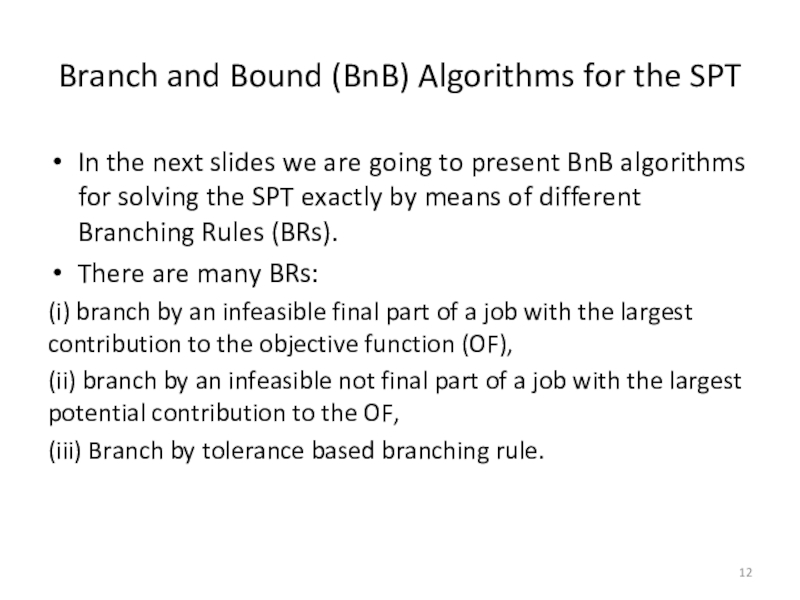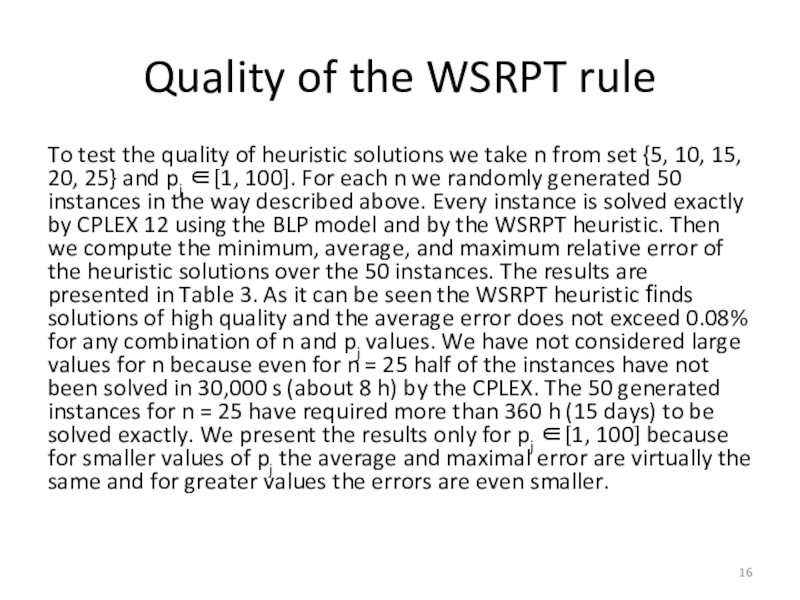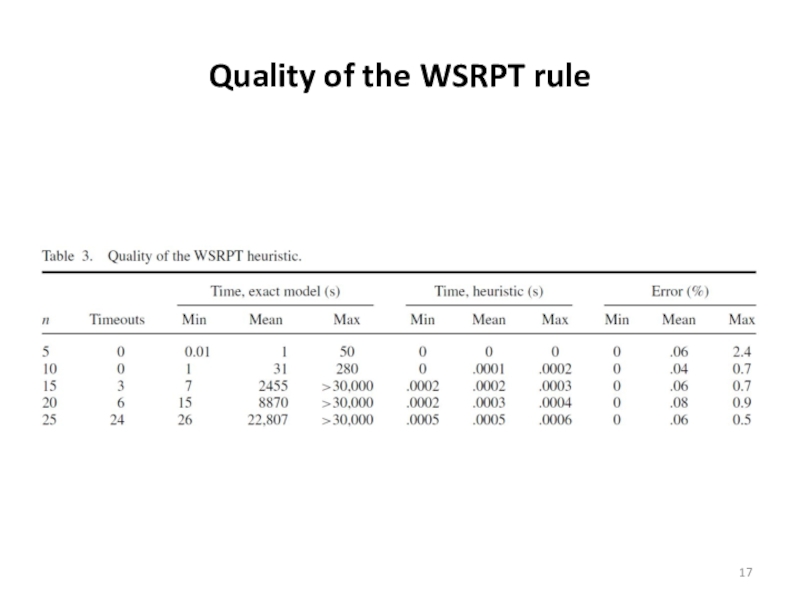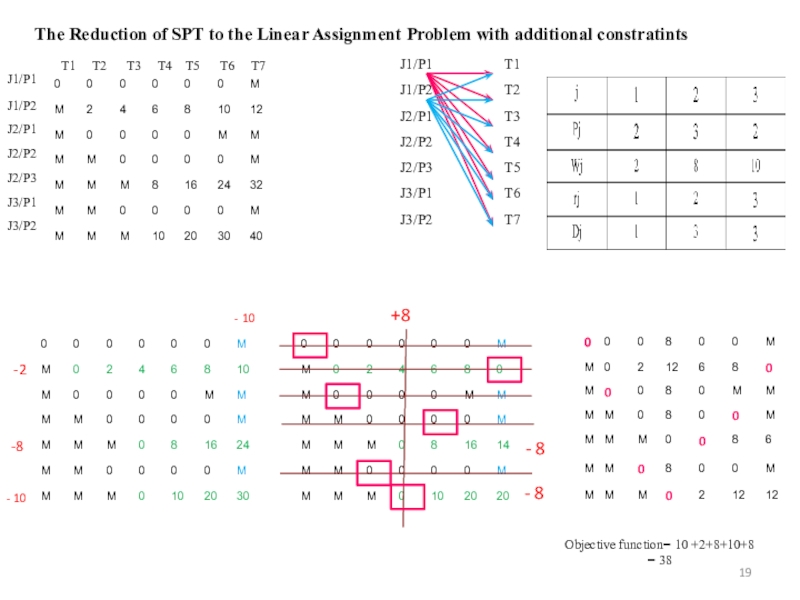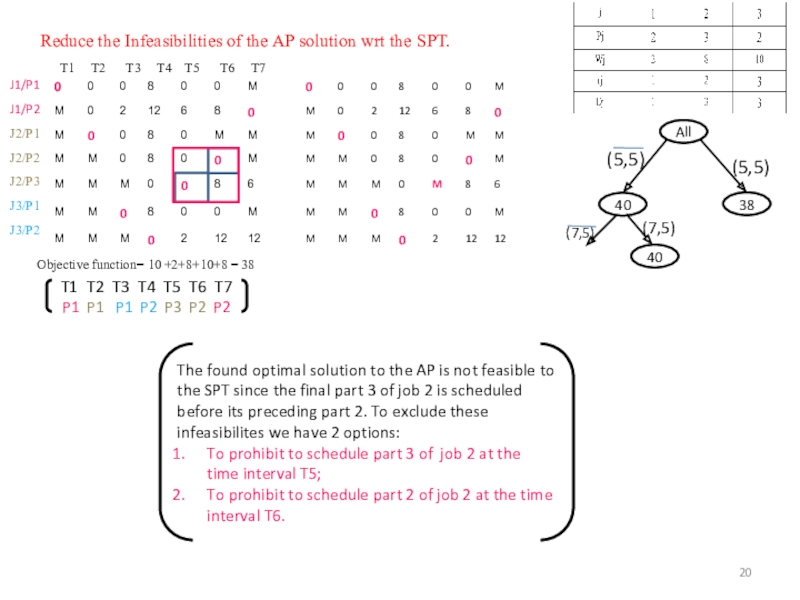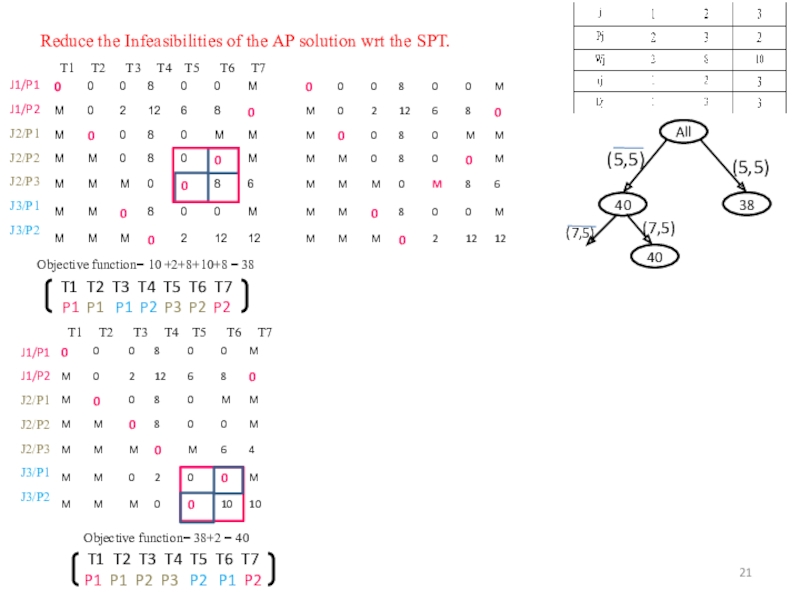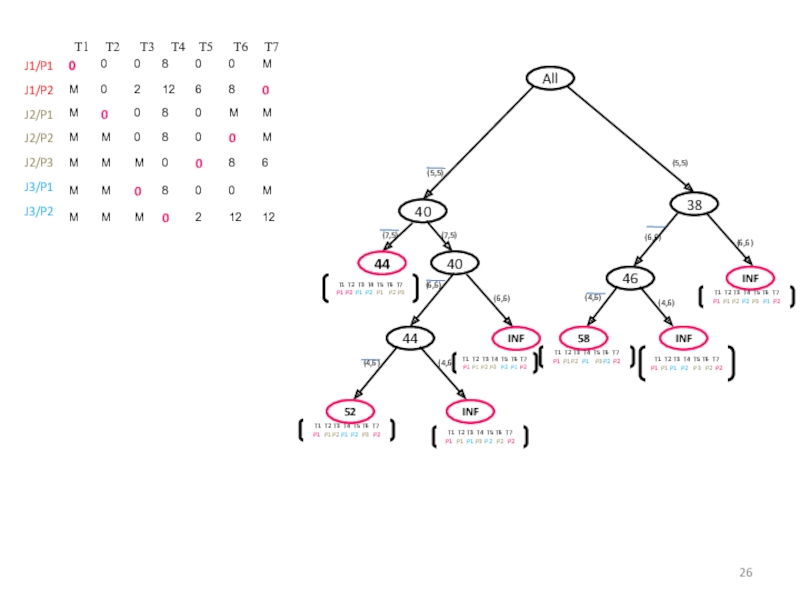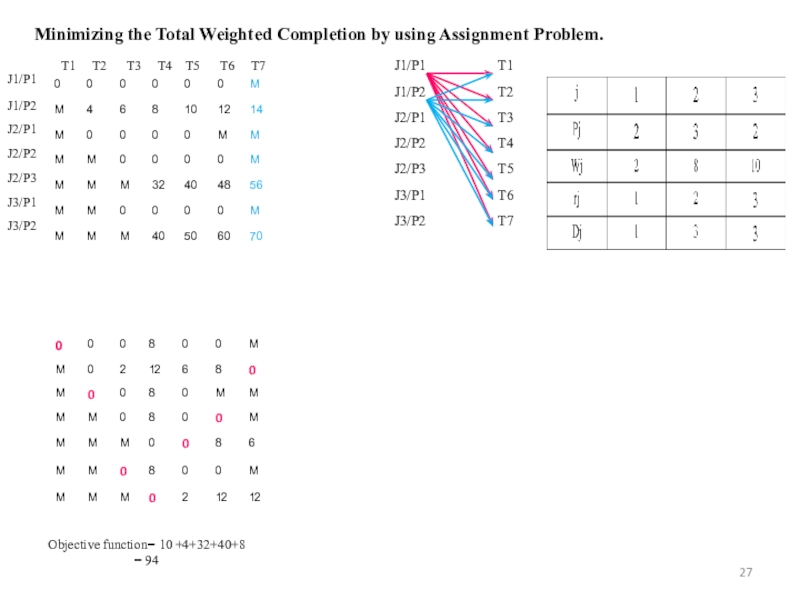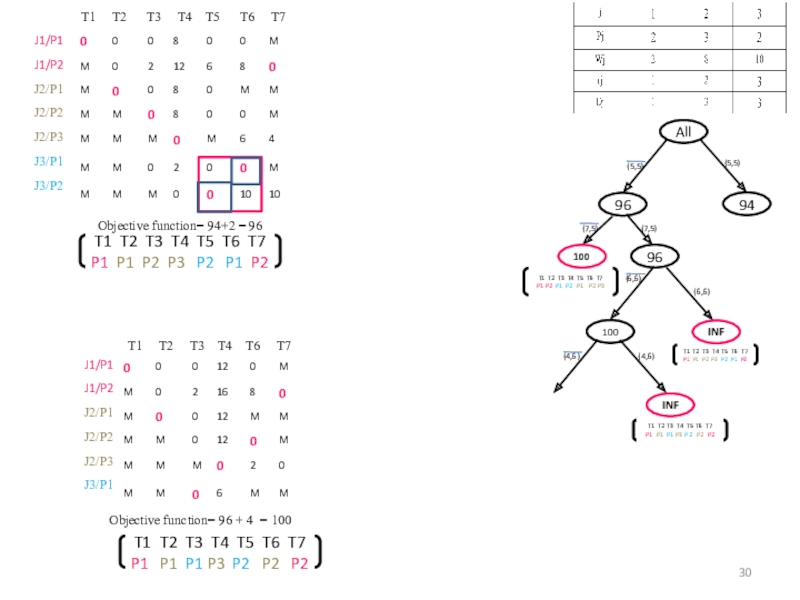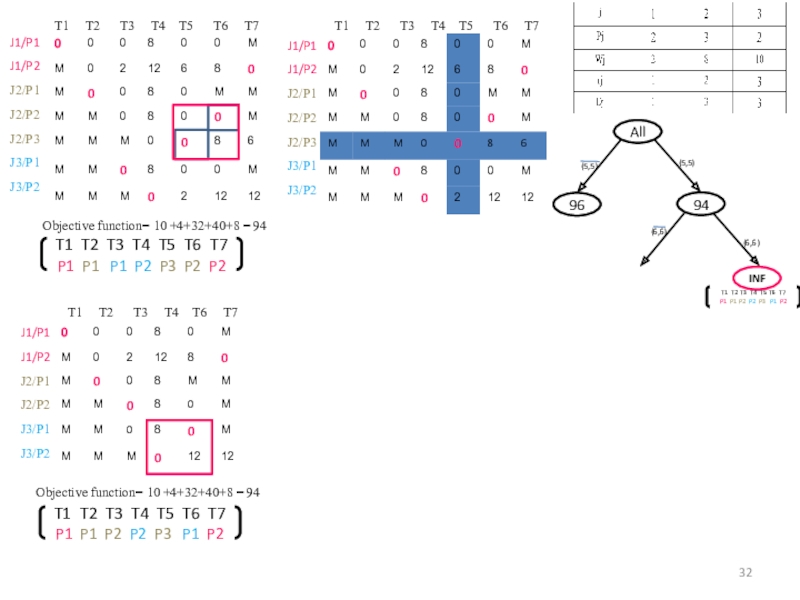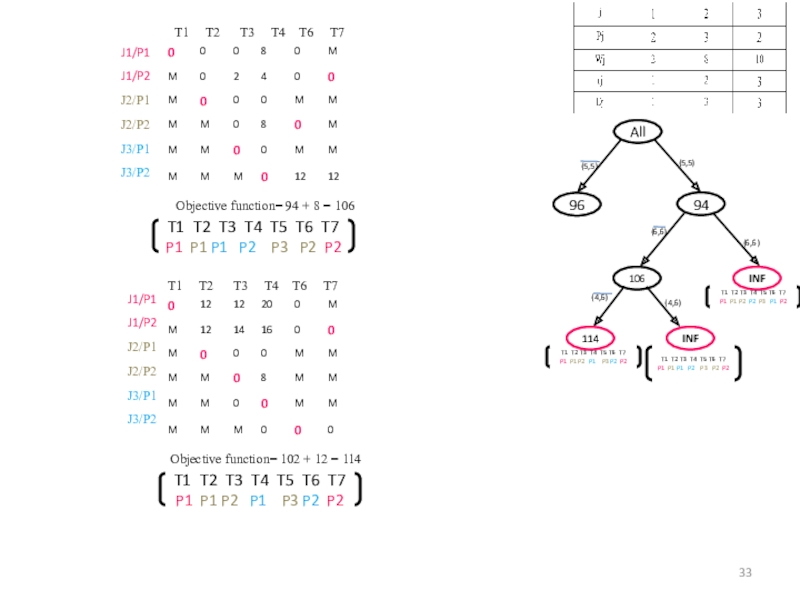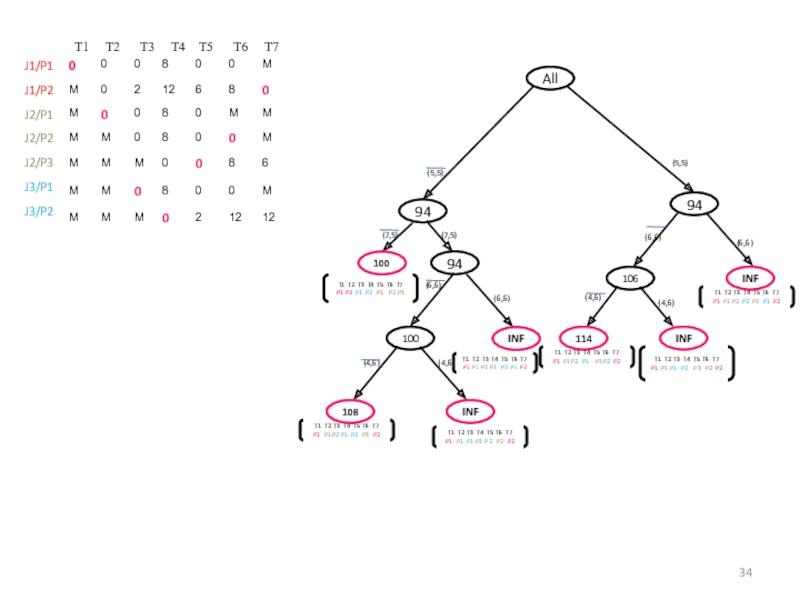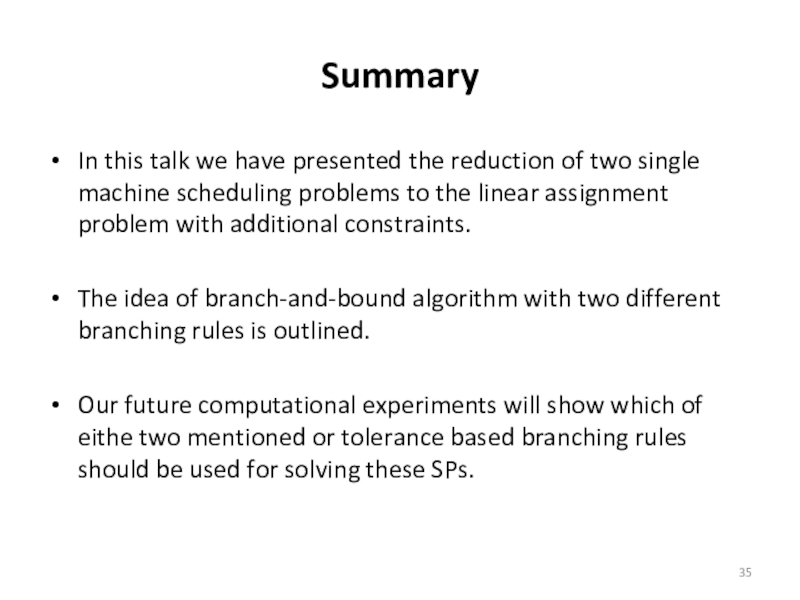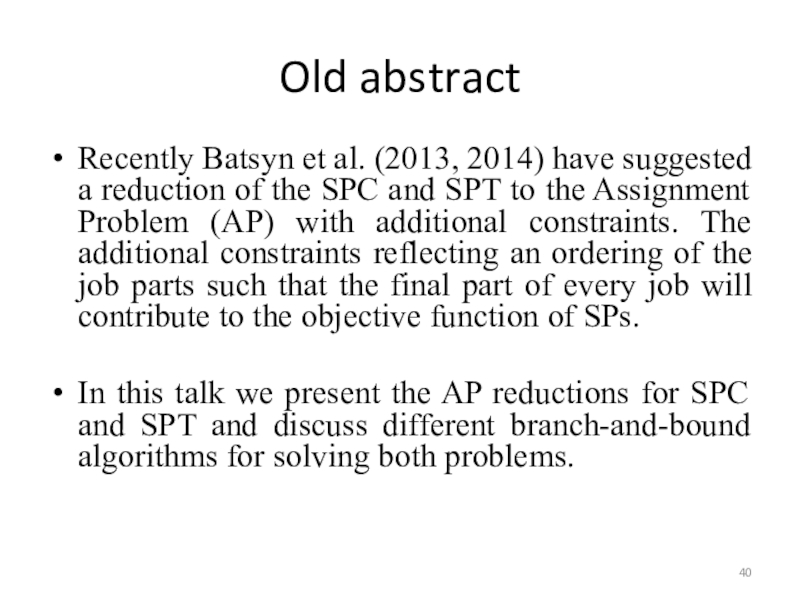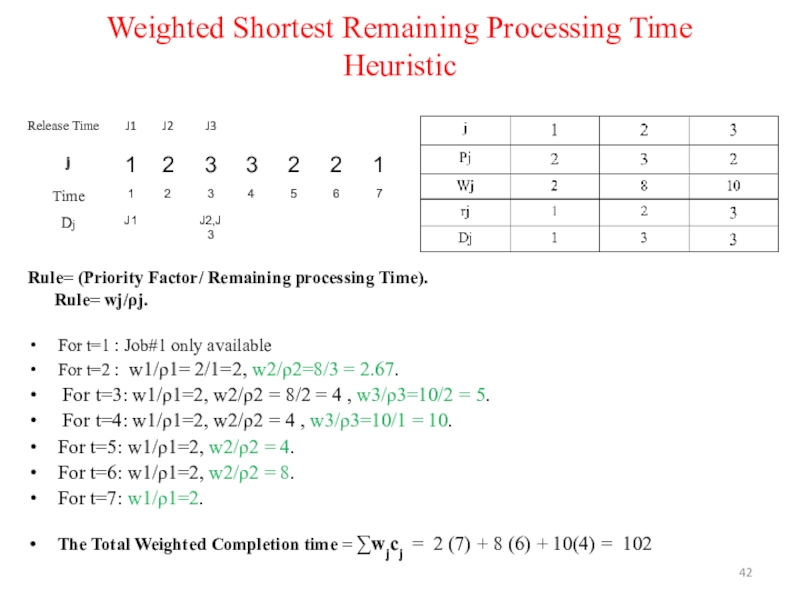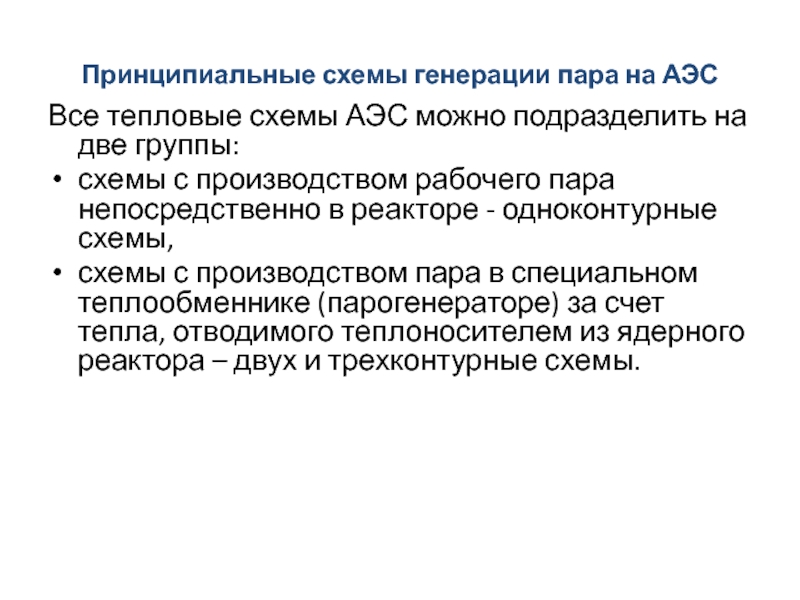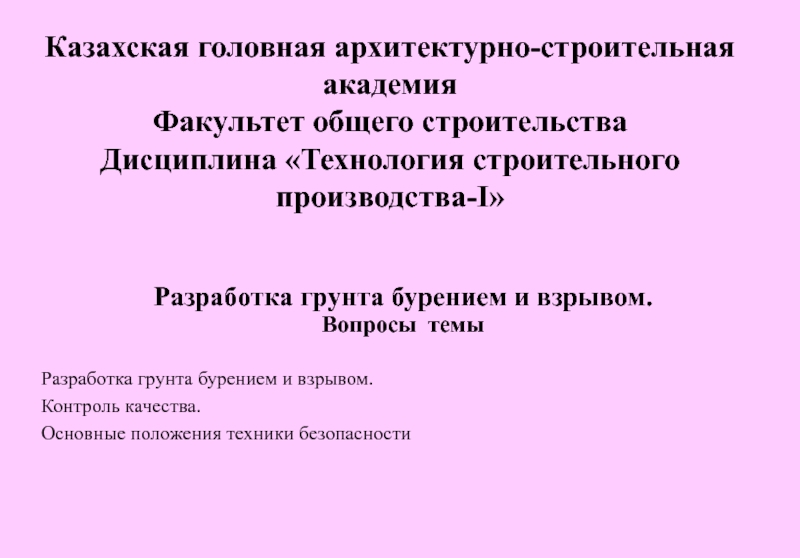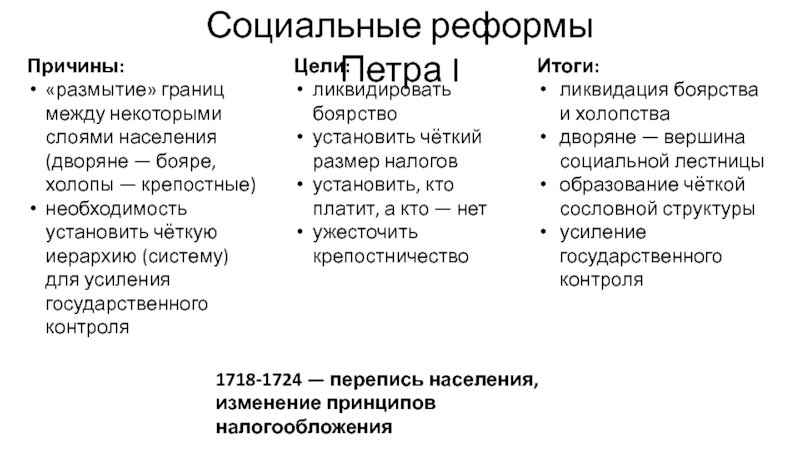Разделы презентаций
- Разное
- Английский язык
- Астрономия
- Алгебра
- Биология
- География
- Геометрия
- Детские презентации
- Информатика
- История
- Литература
- Математика
- Медицина
- Менеджмент
- Музыка
- МХК
- Немецкий язык
- ОБЖ
- Обществознание
- Окружающий мир
- Педагогика
- Русский язык
- Технология
- Физика
- Философия
- Химия
- Шаблоны, картинки для презентаций
- Экология
- Экономика
- Юриспруденция
Single Machine Scheduling Problems can be Reduced to the Linear Assignment
Содержание
- 1. Single Machine Scheduling Problems can be Reduced to the Linear Assignment
- 2. AbstractIn this talk we suggest a unified
- 3. Our ResultsWe present a family of Branch-and-Bound
- 4. Two Single Machine Scheduling ProblemsThe Single Machine
- 5. An example: schedule 3 jobs to minimize
- 6. Informal Reduction to the LAPA feasible solution
- 7. Example 1|pmtn; pj=p; rj|∑wjCj n = 3,
- 8. Lower Bound for the 1|pmtn; pj=p; rj|∑wjCj
- 9. LAP Based Upper BoundThe main drawback of
- 10. Another Reduction of SPC to the LAPThe
- 11. LAP based Upper Bound [1]Theorem 6
- 12. Branch and Bound (BnB) Algorithms for the
- 13. Heuristics in BnB AlgorithmsWe are going to
- 14. WSRPT rule: Computational StudyThe computational experiments are
- 15. CPU times for the WSPRT rule
- 16. Quality of the WSRPT ruleTo test the
- 17. Quality of the WSRPT rule
- 18. Assumptions used in the Reduction of SPs
- 19. The Reduction of SPT to the Linear
- 20. Reduce the Infeasibilities of the AP solution
- 21. Reduce the Infeasibilities of the AP solution
- 22. Objective function= 40+4= 444038 (5,5) (5,5)4440 (7,5)
- 23. 4038 (5,5) (5,5)4440 (7,5)AllT1 T2 T3 T4
- 24. 4038 (5,5) (5,5)AllJ1/P1J1/P2J2/P1J2/P2J2/P3J3/P1J3/P2 T1
- 25. 4038 (5,5) (5,5)AllObjective function= 38 + 8
- 26. 38 (5,5) (6,6) (6,6)INFT1 T2 T3 T4
- 27. Minimizing the Total Weighted Completion by using
- 28. Converge the Infeasible solution to Feasible solution.J1/P1J1/P2J2/P1J2/P2J2/P3J3/P1J3/P2
- 29. Objective function= 96 + 4 = 1009694
- 30. 9694 (5,5) (5,5)10096 (7,5)AllT1 T2 T3 T4
- 31. 9694 (5,5) (5,5)10096 (7,5)AllT1 T2 T3 T4
- 32. 9694 (5,5) (5,5)AllJ1/P1J1/P2J2/P1J2/P2J2/P3J3/P1J3/P2 T1
- 33. 9694 (5,5) (5,5)All (6,6) (6,6)INFT1 T2 T3
- 34. 94 (5,5) (6,6) (6,6)INFT1 T2 T3 T4
- 35. SummaryIn this talk we have presented the
- 36. Future Research DirectionsWe will extend our approach
- 37. References1. M. Batsyn, B. Goldengorin, P. Sukhov,
- 38. Questions?
- 39. Thank you!
- 40. Old abstractRecently Batsyn et al. (2013, 2014)
- 41. Слайд 41
- 42. Weighted Shortest Remaining Processing Time HeuristicRule= (Priority
- 43. Скачать презентанцию
Слайды и текст этой презентации
Слайд 2Abstract
In this talk we suggest a unified reduction of single
machine scheduling problems (with n jobs, arbitrary release and due
dates, processing times, priority factors, preemptions) to the Linear Assignment Problems with Additional Constraints minimizing the following objective functions:The Total Weighted Completion Time,
The Total Weighted Tardiness.
The additional constraints reflecting an ordering of the job parts such that the final part of every job will contribute to the objective function of SPs.
We present the LAP reductions for SPC and SPT and discuss different branch-and-bound algorithms for solving both problems.
Слайд 3Our Results
We present a family of Branch-and-Bound Algorithms with different
branching rules for solving both problems.
In case of equal
processing times (1|pmtn; pj=p; rj|∑wjCj) we provide a lower and upper bounds with approximation ratios ½ and 3/2, respectively, when n tends to infinity and p=2. Слайд 4Two Single Machine Scheduling Problems
The Single Machine Scheduling Problem with
Arbitrary Release Dates, Processing Times, Priorities (Weights), and Preemptions Minimizing
the Total Weighted Processing Time (abbreviated SPC)The Single Machine Scheduling Problem with Arbitrary Release Dates, Processing Times, Priorities (Weights), Preemptions, and Due Dates Minimizing the Total Weighted Tardiness (abbreviated SPT)
The input data for both problems are integer non-negative numbers leading to a schedule without idle intervals
Слайд 5An example: schedule 3 jobs to minimize either the total
weighted completion time or total weighted tardiness.
Since both problems
are NP-hard (computationally intractable) we are going to design heuristics and exact algorithms.Слайд 6Informal Reduction to the LAP
A feasible solution of the scheduling
problem SPC can be represented as an assignment of np
job parts (each of n jobs has p parts) to np time intervals 1, 2,...,np such that every part of job j is assigned to a time interval not earlier than its release date rj . Only the last (p-th) part of every job j is taken into account in the objective function. The cost of its assignment to time t is equal wj t, and the costs for parts 1, 2,...,p − 1 are all equal to 0. The objective is to mini-mize the total cost over all jobs. Thus, SPC problem is equivalent to the linear assignment problem with additional constraints related to release dates rj and also to the sequence of job parts which requires the last part of a job to be assigned to the latest time interval among the time intervals of all its parts. Moreover, release date constraints can be taken into account in the linear assignment problem using infinite costs for the time intervals to which job parts cannot be assigned. For the example at next page, the assignment problem will have the cost matrix shown at the next page.Слайд 8Lower Bound for the 1|pmtn; pj=p; rj|∑wjCj
Theorem 3 [1]
The APL optimal solution provides a value of the objective
function fAPL which is not less than {1/p + 2/(n+1) − 2/[p(n+1)]}fSP, i.e.Слайд 9LAP Based Upper Bound
The main drawback of the LAP that
it does not include the sequence constraints. To incorporate the
sequence constraints, we set the assignment costs cit to be equal to w[(i−1)/p]+1t not only for the last part of a job (when i mod p = 0) but for all its parts. The corresponding matrix for our example is shown at then next slide.Слайд 10Another Reduction of SPC to the LAP
The optimal assignment problem
solution is highlighted with gray color. Now it satisfies all
the constraints of the original SPC problem. Unfortunately, it is not an optimal solution to the SPC problem, because its objective function (OF) is different from OF of the SPC.Слайд 12Branch and Bound (BnB) Algorithms for the SPT
In the next
slides we are going to present BnB algorithms for solving
the SPT exactly by means of different Branching Rules (BRs).There are many BRs:
(i) branch by an infeasible final part of a job with the largest contribution to the objective function (OF),
(ii) branch by an infeasible not final part of a job with the largest potential contribution to the OF,
(iii) Branch by tolerance based branching rule.
Слайд 13Heuristics in BnB Algorithms
We are going to incorporate an efficient
heuristic for the SPC based on the Weighted Shortest Remaining
Processing Time (WSRPT) rule.The computational complexity of our heuristic is based on the WSRPT rule which is O(n) on each step of the heuristic. Since there are no idle time intervals the total number of steps is not greater than npmax. The WSRPT heuristic stores in memory at most nwj/ρj ratios. So the heuristic has time complexity of O(n^2pmax) and space complexity of O(n).
Слайд 14WSRPT rule: Computational Study
The computational experiments are performed on Intel
i7 machine with 2.50 GHz and 8 GB of memory.
Our heuristic is fast enough to solve problems with the number of jobs n = 1000 and the processing times up pj ∼ 1000 in 10 s. For the greater number of jobs n = 10,000 and pj ∼ 10,000 the algorithm needs about 3 h. Average computation times for randomly generated instances are given in Table 2. The average time is computed on 50 instances.Слайд 16Quality of the WSRPT rule
To test the quality of heuristic
solutions we take n from set {5, 10, 15, 20,
25} and pj ∈[1, 100]. For each n we randomly generated 50 instances in the way described above. Every instance is solved exactly by CPLEX 12 using the BLP model and by the WSRPT heuristic. Then we compute the minimum, average, and maximum relative error of the heuristic solutions over the 50 instances. The results are presented in Table 3. As it can be seen the WSRPT heuristic finds solutions of high quality and the average error does not exceed 0.08% for any combination of n and pj values. We have not considered large values for n because even for n = 25 half of the instances have not been solved in 30,000 s (about 8 h) by the CPLEX. The 50 generated instances for n = 25 have required more than 360 h (15 days) to be solved exactly. We present the results only for pj ∈[1, 100] because for smaller values of pj the average and maximal error are virtually the same and for greater values the errors are even smaller.Слайд 18Assumptions used in the Reduction of SPs to the LAP
Every
row in the AP cost matrix is corresponding to a
job part.The order in which the job parts should be processed are fixed by the natural order of rows but can be relaxed such that the final part of every job will be completed after all parts of the same job.
Every column in the AP cost matrix is corresponding to a single time unit interval.
The order of time unit intervals is fixed and represented by natural numbering of columns.
The infeasibility of scheduling a job part to a time interval is indicated by a very large number M, and reflecting the potential contribution to the objective function (the part is not released or cannot be released without creation an idle interval) .
Слайд 19The Reduction of SPT to the Linear Assignment Problem with
additional constratints
J1/P1
+8
T1 T2 T3
T4 T5 T6 T7 J1/P1 T1
J1/P2 T2
J2/P1 T3
J2/P2 T4
J2/P3 T5
J3/P1 T6
J3/P2 T7
J1/P2
J2/P1
J2/P2
J2/P3
J3/P1
J3/P2
- 10
-8
- 8
- 8
- 10
Objective function= 10 +2+8+10+8
= 38
-2
Слайд 20Reduce the Infeasibilities of the AP solution wrt the SPT.
J1/P1
J1/P2
J2/P1
J2/P2
J2/P3
J3/P1
J3/P2
T1 T2 T3
T4 T5 T6 T7Objective function= 10 +2+8+10+8 = 38
40
38
(5,5)
(5,5)
40
(7,5)
(7,5)
T1 T2 T3 T4 T5 T6 T7
P1 P1 P1 P2 P3 P2 P2
All
The found optimal solution to the AP is not feasible to the SPT since the final part 3 of job 2 is scheduled before its preceding part 2. To exclude these infeasibilites we have 2 options:
To prohibit to schedule part 3 of job 2 at the time interval T5;
To prohibit to schedule part 2 of job 2 at the time interval T6.
Слайд 21Reduce the Infeasibilities of the AP solution wrt the SPT.
J1/P1
J1/P2
J2/P1
J2/P2
J2/P3
J3/P1
J3/P2
Objective
function= 38+2 = 40
T1 T2
T3 T4 T5 T6 T7 Objective function= 10 +2+8+10+8 = 38
40
38
(5,5)
(5,5)
40
(7,5)
(7,5)
T1 T2 T3 T4 T5 T6 T7
P1 P1 P1 P2 P3 P2 P2
All
T1 T2 T3 T4 T5 T6 T7
P1 P1 P2 P3 P2 P1 P2
T1 T2 T3 T4 T5 T6 T7
J1/P1
J1/P2
J2/P1
J2/P2
J2/P3
J3/P1
J3/P2
Слайд 22Objective function= 40+4= 44
40
38
(5,5)
(5,5)
44
40
(7,5)
(7,5)
All
T1 T2 T3
T4 T5 T6 T7
P1 P2 P1 P2 P1
P2 P3T1 T2 T3 T4 T5 T6 T7
P1 P2 P1 P2 P1 P2 P3
J1/P1
J1/P2
J2/P1
J2/P2
J2/P3
J3/P1
J3/P2
T1 T2 T3 T4 T5 T6 T7
T1 T2 T3 T4 T5 T6 T7
P1 P1 P2 P3 P2 P1 P2
Objective function= 38+2 = 40
T1 T2 T3 T4 T5 T6 T7
J1/P1
J1/P2
J2/P1
J2/P2
J2/P3
J3/P1
J3/P2
Слайд 2340
38
(5,5)
(5,5)
44
40
(7,5)
All
T1 T2 T3 T4 T5 T6 T7
P1
P2 P1 P2 P1 P2 P3
INF
T1 T2 T3
T4 T5 T6 T7P1 P1 P2 P3 P2 P1 P2
T1 T2 T3 T4 T5 T6 T7
P1 P1 P2 P3 P2 P1 P2
Objective function= 38+2 = 40
T1 T2 T3 T4 T5 T6 T7
J1/P1
J1/P2
J2/P1
J2/P2
J2/P3
J3/P1
J3/P2
(6,6)
(6,6)
(7,5)
T1 T2 T3 T4 T5 T6 T7
P1 P1 P1 P3 P2 P2 P2
J1/P1
J1/P2
J2/P1
J2/P2
J2/P3
J3/P1
T1 T2 T3 T4 T6 T7
Objective function= 40 + 4 = 44
INF
T1 T2 T3 T4 T5 T6 T7
P1 P1 P1 P3 P2 P2 P2
44
(4,6)
(4,6)
T1 T2 T3 T4 T5 T6 T7
P1 P1 P2 P1 P2 P3 P2
T1 T2 T3 T4 T6 T7
J1/P1
J1/P2
J2/P1
J2/P2
J2/P3
J3/P1
Objective function= 44+ 6 + 2 = 52
T1 T2 T3 T4 T5 T6 T7
P1 P1 P2 P1 P2 P3 P2
52
Слайд 2440
38
(5,5)
(5,5)
All
J1/P1
J1/P2
J2/P1
J2/P2
J2/P3
J3/P1
J3/P2
T1 T2
T3 T4 T5 T6
T7Objective function= 10 +2+8+10+8 = 38
T1 T2 T3 T4 T5 T6 T7
P1 P1 P1 P2 P3 P2 P2
J1/P1
J1/P2
J2/P1
J2/P2
J2/P3
J3/P1
J3/P2
T1 T2 T3 T4 T5 T6 T7
J1/P1
J1/P2
J2/P1
J2/P2
J3/P1
J3/P2
T1 T2 T3 T4 T6 T7
Objective function= 10 +2+8+10+8 = 38
T1 T2 T3 T4 T5 T6 T7
P1 P1 P2 P2 P3 P1 P2
(6,6)
(6,6)
INF
T1 T2 T3 T4 T5 T6 T7
P1 P1 P2 P2 P3 P1 P2
Слайд 2540
38
(5,5)
(5,5)
All
Objective function= 38 + 8 = 46
(6,6)
(6,6)
INF
T1 T2 T3 T4 T5 T6 T7
P1 P1 P2 P2
P3 P1 P2J1/P1
J1/P2
J2/P1
J2/P2
J3/P1
J3/P2
T1 T2 T3 T4 T6 T7
T1 T2 T3 T4 T5 T6 T7
P1 P1 P1 P2 P3 P2 P2
T1 T2 T3 T4 T5 T6 T7
P1 P1 P1 P2 P3 P2 P2
46
INF
(4,6)
(4,6)
J1/P1
J1/P2
J2/P1
J2/P2
J3/P1
J3/P2
T1 T2 T3 T4 T6 T7
T1 T2 T3 T4 T5 T6 T7
P1 P1 P2 P1 P3 P2 P2
Objective function= 46 + 12 = 58
58
T1 T2 T3 T4 T5 T6 T7
P1 P1 P2 P1 P3 P2 P2
Слайд 2638
(5,5)
(6,6)
(6,6)
INF
T1 T2 T3 T4 T5 T6 T7
P1
P1 P2 P2 P3 P1 P2
T1 T2 T3 T4
T5 T6 T7P1 P1 P1 P2 P3 P2 P2
46
INF
(4,6)
(4,6)
58
T1 T2 T3 T4 T5 T6 T7
P1 P1 P2 P1 P3 P2 P2
40
(5,5)
44
40
(7,5)
All
T1 T2 T3 T4 T5 T6 T7
P1 P2 P1 P2 P1 P2 P3
INF
T1 T2 T3 T4 T5 T6 T7
P1 P1 P2 P3 P2 P1 P2
(6,6)
(6,6)
(7,5)
INF
T1 T2 T3 T4 T5 T6 T7
P1 P1 P1 P3 P2 P2 P2
44
(4,6)
(4,6)
T1 T2 T3 T4 T5 T6 T7
P1 P1 P2 P1 P2 P3 P2
52
T1 T2 T3 T4 T5 T6 T7
J1/P1
J1/P2
J2/P1
J2/P2
J2/P3
J3/P1
J3/P2
Слайд 27Minimizing the Total Weighted Completion by using Assignment Problem.
J1/P1
T1 T2 T3 T4
T5 T6 T7J1/P1 T1
J1/P2 T2
J2/P1 T3
J2/P2 T4
J2/P3 T5
J3/P1 T6
J3/P2 T7
J1/P2
J2/P1
J2/P2
J2/P3
J3/P1
J3/P2
Objective function= 10 +4+32+40+8
= 94
Слайд 28Converge the Infeasible solution to Feasible solution.
J1/P1
J1/P2
J2/P1
J2/P2
J2/P3
J3/P1
J3/P2
T1
T2 T3 T4 T5
T6 T796
94
(5,5)
(5,5)
96
(7,5)
(7,5)
T1 T2 T3 T4 T5 T6 T7
P1 P1 P1 P2 P3 P2 P2
All
T1 T2 T3 T4 T5 T6 T7
P1 P1 P2 P3 P2 P1 P2
T1 T2 T3 T4 T5 T6 T7
Objective function= 10 +4+32+40+8 = 94
Objective function= 94 + 2 = 96
J1/P1
J1/P2
J2/P1
J2/P2
J2/P3
J3/P1
J3/P2
Слайд 29Objective function= 96 + 4 = 100
96
94
(5,5)
(5,5)
100
96
(7,5)
(7,5)
All
T1 T2 T3 T4 T5 T6 T7
P1 P2 P1 P2
P1 P2 P3T1 T2 T3 T4 T5 T6 T7
P1 P2 P1 P2 P1 P2 P3
INF
T1 T2 T3 T4 T5 T6 T7
P1 P1 P2 P3 P2 P1 P2
J1/P1
J1/P2
J2/P1
J2/P2
J2/P3
J3/P1
J3/P2
T1 T2 T3 T4 T5 T6 T7
T1 T2 T3 T4 T5 T6 T7
P1 P1 P2 P3 P2 P1 P2
Objective function= 94+2 = 96
T1 T2 T3 T4 T5 T6 T7
J1/P1
J1/P2
J2/P1
J2/P2
J2/P3
J3/P1
J3/P2
(6,6)
(6,6)
Слайд 3096
94
(5,5)
(5,5)
100
96
(7,5)
All
T1 T2 T3 T4 T5 T6 T7
P1
P2 P1 P2 P1 P2 P3
INF
T1 T2 T3
T4 T5 T6 T7P1 P1 P2 P3 P2 P1 P2
T1 T2 T3 T4 T5 T6 T7
P1 P1 P2 P3 P2 P1 P2
T1 T2 T3 T4 T5 T6 T7
J1/P1
J1/P2
J2/P1
J2/P2
J2/P3
J3/P1
J3/P2
(6,6)
(6,6)
(7,5)
T1 T2 T3 T4 T5 T6 T7
P1 P1 P1 P3 P2 P2 P2
J1/P1
J1/P2
J2/P1
J2/P2
J2/P3
J3/P1
T1 T2 T3 T4 T6 T7
Objective function= 96 + 4 = 100
INF
T1 T2 T3 T4 T5 T6 T7
P1 P1 P1 P3 P2 P2 P2
100
(4,6)
(4,6)
Objective function= 94+2 = 96
Слайд 3196
94
(5,5)
(5,5)
100
96
(7,5)
All
T1 T2 T3 T4 T5 T6 T7
P1
P2 P1 P2 P1 P2 P3
INF
T1 T2 T3
T4 T5 T6 T7P1 P1 P2 P3 P2 P1 P2
(6,6)
(6,6)
(7,5)
T1 T2 T3 T4 T5 T6 T7
P1 P1 P2 P1 P2 P3 P2
INF
T1 T2 T3 T4 T5 T6 T7
P1 P1 P1 P3 P2 P2 P2
100
(4,6)
(4,6)
T1 T2 T3 T4 T6 T7
J1/P1
J1/P2
J2/P1
J2/P2
J2/P3
J3/P1
Objective function= 100+ 6 + 2 =108
T1 T2 T3 T4 T5 T6 T7
P1 P1 P2 P1 P2 P3 P2
108
Слайд 3296
94
(5,5)
(5,5)
All
J1/P1
J1/P2
J2/P1
J2/P2
J2/P3
J3/P1
J3/P2
T1 T2
T3 T4 T5 T6
T7T1 T2 T3 T4 T5 T6 T7
P1 P1 P1 P2 P3 P2 P2
J1/P1
J1/P2
J2/P1
J2/P2
J2/P3
J3/P1
J3/P2
T1 T2 T3 T4 T5 T6 T7
J1/P1
J1/P2
J2/P1
J2/P2
J3/P1
J3/P2
T1 T2 T3 T4 T6 T7
T1 T2 T3 T4 T5 T6 T7
P1 P1 P2 P2 P3 P1 P2
Objective function= 10 +4+32+40+8 = 94
Objective function= 10 +4+32+40+8 = 94
(6,6)
(6,6)
INF
T1 T2 T3 T4 T5 T6 T7
P1 P1 P2 P2 P3 P1 P2
Слайд 3396
94
(5,5)
(5,5)
All
(6,6)
(6,6)
INF
T1 T2 T3 T4 T5 T6
T7
P1 P1 P2 P2 P3 P1 P2
J1/P1
J1/P2
J2/P1
J2/P2
J3/P1
J3/P2
T1
T2 T3 T4 T6 T7 T1 T2 T3 T4 T5 T6 T7
P1 P1 P1 P2 P3 P2 P2
T1 T2 T3 T4 T5 T6 T7
P1 P1 P1 P2 P3 P2 P2
106
INF
(4,6)
(4,6)
J1/P1
J1/P2
J2/P1
J2/P2
J3/P1
J3/P2
T1 T2 T3 T4 T6 T7
T1 T2 T3 T4 T5 T6 T7
P1 P1 P2 P1 P3 P2 P2
Objective function= 102 + 12 = 114
114
T1 T2 T3 T4 T5 T6 T7
P1 P1 P2 P1 P3 P2 P2
Objective function= 94 + 8 = 106
Слайд 3494
(5,5)
(6,6)
(6,6)
INF
T1 T2 T3 T4 T5 T6 T7
P1
P1 P2 P2 P3 P1 P2
T1 T2 T3 T4
T5 T6 T7P1 P1 P1 P2 P3 P2 P2
106
INF
(4,6)
(4,6)
114
T1 T2 T3 T4 T5 T6 T7
P1 P1 P2 P1 P3 P2 P2
94
(5,5)
100
94
(7,5)
All
T1 T2 T3 T4 T5 T6 T7
P1 P2 P1 P2 P1 P2 P3
INF
T1 T2 T3 T4 T5 T6 T7
P1 P1 P2 P3 P2 P1 P2
(6,6)
(6,6)
(7,5)
INF
T1 T2 T3 T4 T5 T6 T7
P1 P1 P1 P3 P2 P2 P2
100
(4,6)
(4,6)
T1 T2 T3 T4 T5 T6 T7
P1 P1 P2 P1 P2 P3 P2
108
T1 T2 T3 T4 T5 T6 T7
J1/P1
J1/P2
J2/P1
J2/P2
J2/P3
J3/P1
J3/P2
Слайд 35Summary
In this talk we have presented the reduction of two
single machine scheduling problems to the linear assignment problem with
additional constraints.The idea of branch-and-bound algorithm with two different branching rules is outlined.
Our future computational experiments will show which of eithe two mentioned or tolerance based branching rules should be used for solving these SPs.
Слайд 36Future Research Directions
We will extend our approach to the following
objective functions:
Minimize the maximum lateness (Lj=Cj – dj);
Minimize the
makespan (Cmax);Minimize the weighted number of tardy jobs;
Minimize the total weighted earliness (note that the earliness penalty is nonincreasing in Cj (Ej=max{dj – Cj, 0}).
Minimize the linear combination of the total weighted earliness and the total weighted tardiness with arbitrary weights.
We will design tolerance based branching rules and bounds with the purpose to reduce the total CPU times compared to the costs based counterparts.
Слайд 37References
1. M. Batsyn, B. Goldengorin, P. Sukhov, P. M. Pardalos.
Lower and Upper Bounds for the Preemptive Single Machine Scheduling
Problem with Equal Processing Times. Springer Proceedings in Mathematics & Statistics, Vol. 59, 11–30, 2013.2. M. Batsyn, B. Goldengorin, P. Sukhov, P. M. Pardalos. Online heuristic for the preemptive single machine scheduling problem of minimizing the total weighted completion time. Optimization Methods and Software, 2014, 29(5):955–963.
Слайд 40Old abstract
Recently Batsyn et al. (2013, 2014) have suggested a
reduction of the SPC and SPT to the Assignment Problem
(AP) with additional constraints. The additional constraints reflecting an ordering of the job parts such that the final part of every job will contribute to the objective function of SPs.In this talk we present the AP reductions for SPC and SPT and discuss different branch-and-bound algorithms for solving both problems.
Слайд 42Weighted Shortest Remaining Processing Time Heuristic
Rule= (Priority Factor/ Remaining processing
Time).
Rule= wj/ρj.
For t=1 : Job#1 only available
For t=2 : w1/ρ1= 2/1=2, w2/ρ2=8/3 = 2.67.
For t=3: w1/ρ1=2, w2/ρ2 = 8/2 = 4 , w3/ρ3=10/2 = 5.
For t=4: w1/ρ1=2, w2/ρ2 = 4 , w3/ρ3=10/1 = 10.
For t=5: w1/ρ1=2, w2/ρ2 = 4.
For t=6: w1/ρ1=2, w2/ρ2 = 8.
For t=7: w1/ρ1=2.
The Total Weighted Completion time = ∑wjcj = 2 (7) + 8 (6) + 10(4) = 102


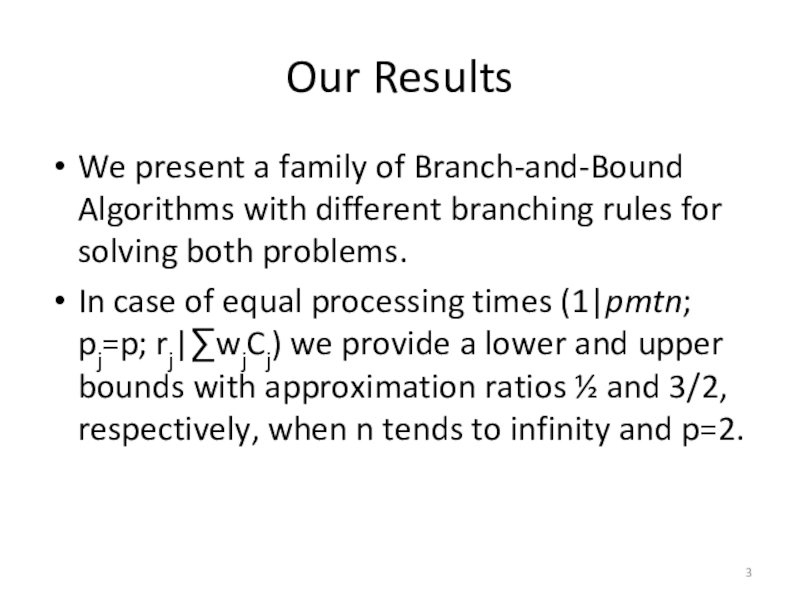
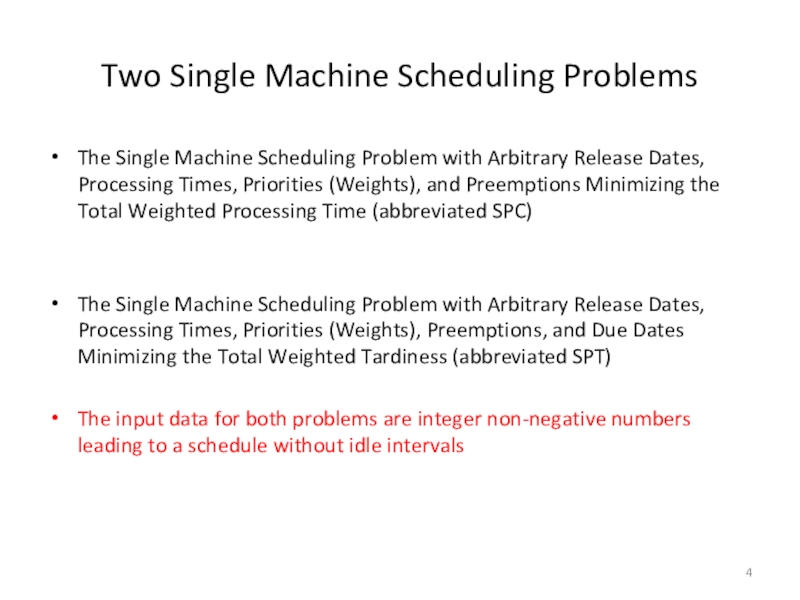

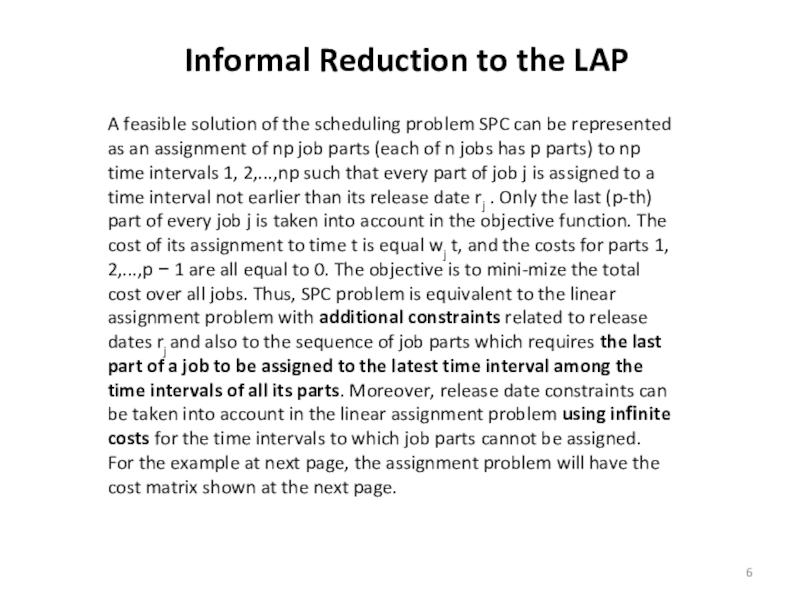
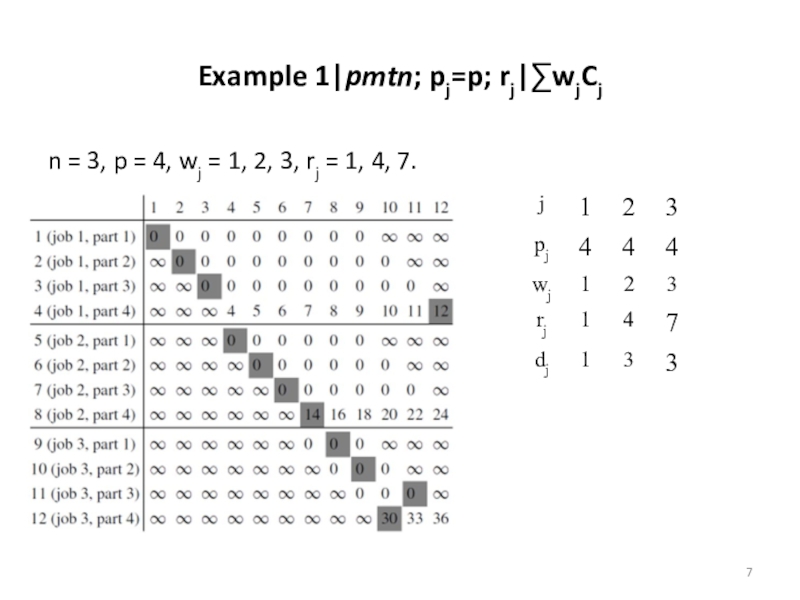
![Single Machine Scheduling Problems can be Reduced to the Linear Assignment Lower Bound for the 1|pmtn; pj=p; rj|∑wjCj Theorem 3 [1] The Lower Bound for the 1|pmtn; pj=p; rj|∑wjCj Theorem 3 [1] The APL optimal solution provides a value](/img/thumbs/be84237191008990343557b3ce707d1b-800x.jpg)
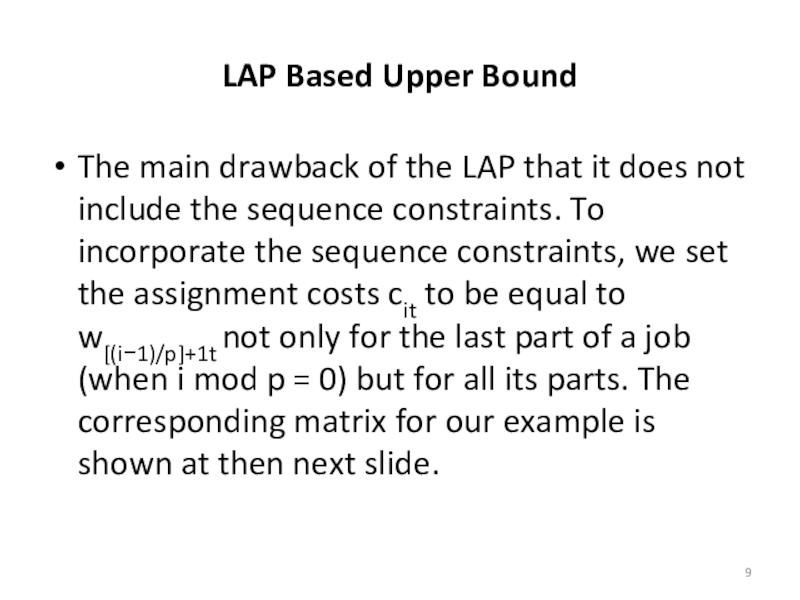
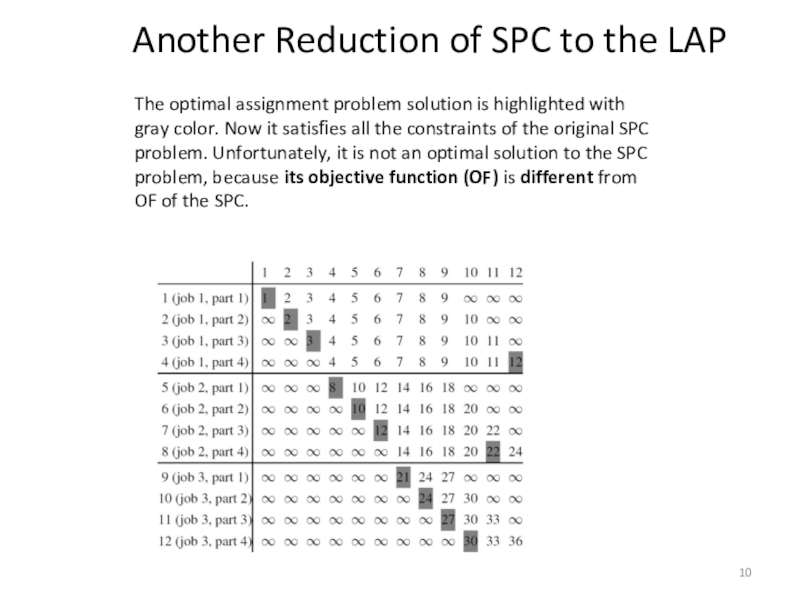
![Single Machine Scheduling Problems can be Reduced to the Linear Assignment LAP based Upper Bound [1]Theorem 6 LAP based Upper Bound [1]Theorem 6](/img/thumbs/788a8106e80db86f313e069d97f88a17-800x.jpg)
